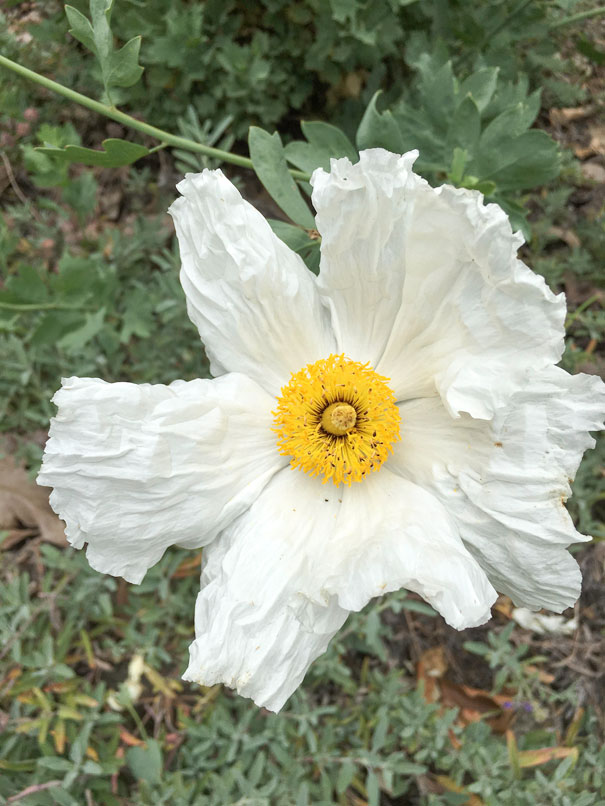LETTERS FROM THE GARDEN
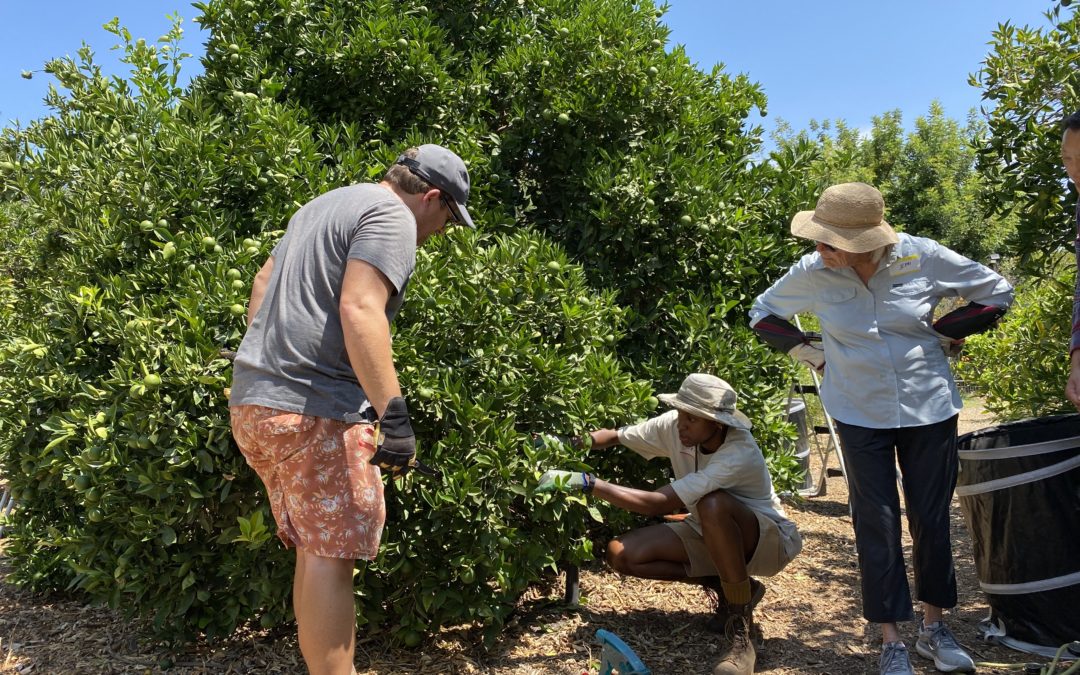
Backyard Urban Gardening and Acts of Remembering: Capri Williams and Joanna Glovinsky
Pictured: Citrus 101 workshop participants with Capri Williams (center) Credit: Joanna Glovinsky
Joanna Glovinsky is the founder of local fruit tree education and service provider Fruitstitute. Capri Williams is a horticulturist and expert fruit tree educator. Arlington Garden partnered with Fruitstitute in the summer of 2021 to offer workshops (“Citrus 101”) in our orange grove. The following interview has been edited for clarity and length.
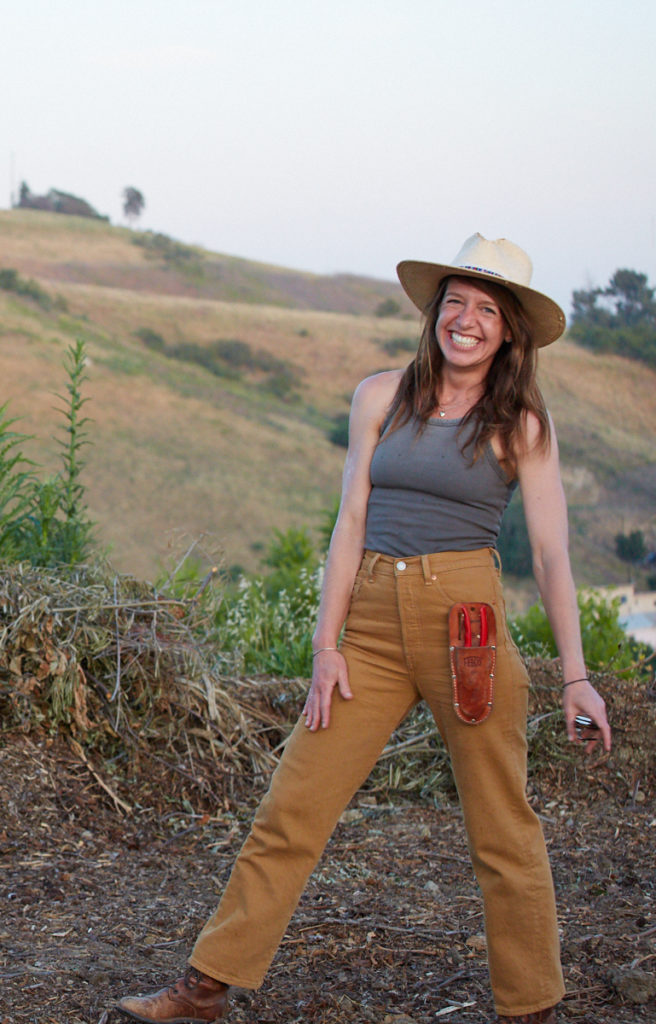 AG: Could you tell us a little bit about how you became interested in the noble profession of horticulture? What experiences led you to start Fruitstitute, Joanna?
AG: Could you tell us a little bit about how you became interested in the noble profession of horticulture? What experiences led you to start Fruitstitute, Joanna?
Joanna Glovinsky: Before I lived in Los Angeles, I was living in Guatemala in an agrarian society. That’s when my food changed, my body changed, everything changed. That’s also where I got into food and learned about food systems.
I got into graduate school here at USC, and my biggest concern about moving back to the States was ‘what am I gonna eat?’ So I’m in school for communications getting my Masters in like, propaganda essentially, but uh….
AG: Just your usual skill!
JG: Yeah! I mean, I always say I got my Master’s in communications and came out a gardener. But that’s pretty much what happened! When I was in grad school, I started working for Ron Finley, and that’s how I got into the world of urban agriculture.
I graduated from school and had my “dream job” [lined up at a think tank], and I was like… “Yeah, I’d rather be shoveling shit!” And that was when I realized that I needed to pursue horticultural work. I volunteered at Huntington Ranch, which is where I took my first class in fruit tree pruning, and I realized: oh, I get fruit tree pruning … I was born to prune!
From there I started working for Fallen Fruit. And that is how [eventually] I ended up founding Fruitstitute. read more…
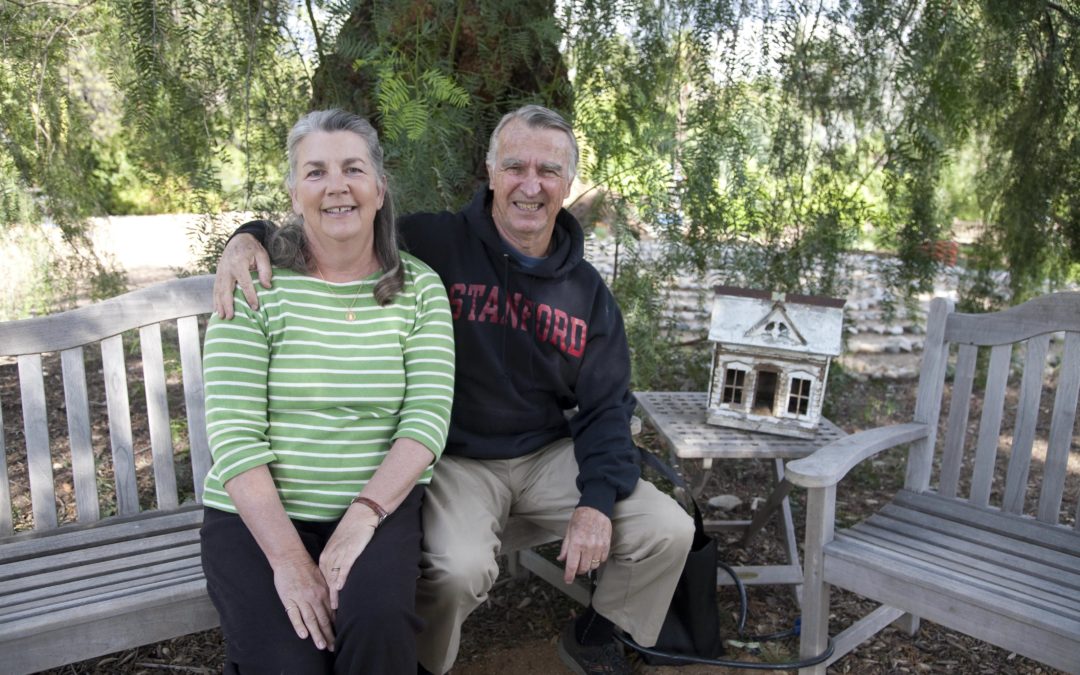
Remembering Betty and Charles McKenney: George Brumder
Pictured: Betty and Charles “Kicker” McKenney
George Brumder is former President of the Arlington Garden in Pasadena Board of Directors and current Board member. He has been a supporter of Arlington Garden since its beginning. In this interview, he discusses the early stages of Arlington Garden and the role of our founders Betty and Charles “Kicker” McKenney in its creation.
AG: How did you first become involved with the garden? What led you to become a supporter and board member?
George Brumder (GB): I grew up in Milwaukee, a place where there are four entirely distinct seasons, and my family spent summers and many weekends during the year in the country on a lake in the woods. Nature was always close, important and appreciated by me and my family.
My wife Marilyn and I have lived in Pasadena for over 50 years, and we’ve always been involved with our own gardens at home. From early 1999 through 2010 I was the founding chair of the Southern California branch of the Mediterranean Garden Society, a non-profit organization headquartered in Athens that’s a resource for gardeners in the world’s mediterranean climate regions. I was on the MGS board from 2004 through 2012. In 1999 I joined the LA Arboretum’s board of trustees and was board president for 4-plus years starting in 2000. I’ve been on the board of the Men’s Garden Club of Los Angeles since 1993, and I was program chair for 6-plus years and president in 2005 and 2006. Marilyn and I have visited many gardens, gardeners, garden designers, garden writers and plantspeople around the world.
I know meaningful connections with nature contribute to physical, mental and emotional health. I also know that gardens are places of learning, enjoyment and inspiration. We’re in a mediterranean climate, and it’s important for people to know that and understand what that means. Increasingly as our population density grows, too few Southern Californians have a real connection with nature. Arlington Garden responds to all these considerations, so I’m happy to help. read more…
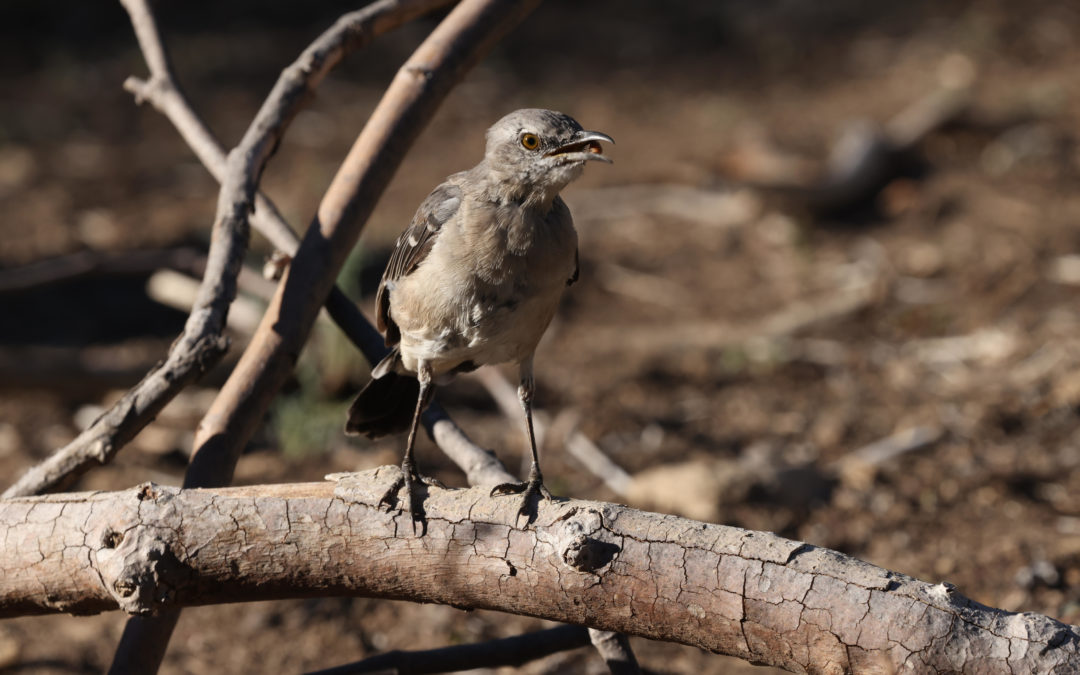
Native Birds of Arlington Garden: Bob Gorcik
Northern Mockingbird, image courtesy of William Hallstrom.
Bob Gorcik volunteers at Arlington Garden. He has been a birder since he was in middle school. As an undergraduate in college, he was a wildlife research assistant, which allowed him to study birds up close.
In this segment I’ll be introducing some of the native birds that can be seen in and around not only Arlington Garden but also in some common urban California environments, such as small city parks and the minimal landscaping surrounding apartment buildings.
Perhaps the best local bird to start out with is the familiar gray-colored long-tailed Northern Mockingbird (Mimus polyglottos). Despite the name, they are generally only found in the southern half of the US (and Mexico) where they are typically the most common native songbird in urban and suburban areas. Easily identified by their ability to mimic other birds (hence their name) they sometimes sing well into the night, especially during mating season, often to the annoyance of local residents who are trying to sleep!
Another of the most common native birds that can be found not only in Arlington Garden but around nearly any residential street and small city park is the House Finch (Haemorhous mexicanus). These common finches, characterized by the red-headed males were originally only found in the southwest quarter of the US until introduced to the east coast in the 1940s and is now found across the mid-latitudes of North America.
A member of the Flycatcher family of passerines, the Black Phoebe (Sayornis nigricans) is more limited to California and parts of the US Southwest than the previously two mentioned birds. The original habitat of Black Phoebes were any riparian corridors with abundant vegetation and flying insects to eat, especially where there is steep river banks for nesting, but they have adapted very well to similarly nesting under roof eaves of buildings wherever there are trees nearby and water from hoses and sprinklers and their subsequent runoff. read more…

Freeways: A Brief History of Demolition and Separation
Brian Biery is a community organizer, documentary photographer, and Adjunct Professor of Advocacy/Social Justice at Pacific Oaks College. His world view has been shaped by serving as a Peace Corps Volunteer in Guatemala and by engaging his community on social justice issues for over 20 years.
The construction of freeways and interstate highways has long been the subject of intense scrutiny. Who decides which route should be taken and what is their rationale for making that decision? How do highways impact communities of color? How are displaced families relocated and made whole financially? What are the health impacts of major highways located adjacent to residential areas? Which communities suffer the brunt of those impacts? And, here in Southern California, will the freeway soon become obsolete and require further enhancements to meet the needs of a society that is dependent on motorized vehicles?
Historically racial and economic segregation in urban communities is often described as a natural consequence of poor choices by individuals. In reality, however, racially and economically segregated cities are the result of many factors, including the nation’s interstate highway system. In states around the country, highway construction displaced poor and minority households. And it cut the heart and soul out of thriving minority communities as homes, churches, schools, and businesses were destroyed. read more…
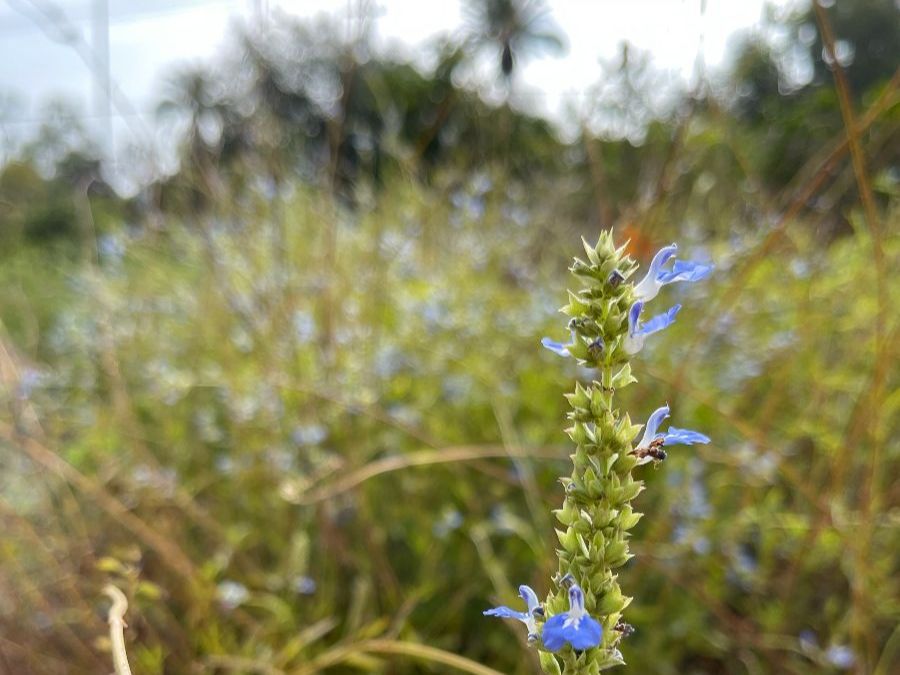
The Future of the California Lawn
Paloma Avila is Program and Development Manager at Arlington Garden Pasadena and co-host of Beyond Freeways.
According to the University of California Cooperative Extension, landscape irrigation accounts for about 50% of annual residential water consumption statewide. Since lawn irrigation makes up such a large proportion of this consumption, one simple way we can reduce residential water use quickly is by removing non-native, water-demanding lawns. In addition to the water demands of turf, lawn irrigation wastes water through run-off and introduces pesticides and chemical fertilizers into the ecosystem. Even “water-wise” technologies create harmful impacts when installed incorrectly.
Given the negative environmental impacts, why are lawns so pervasive in California? read more…
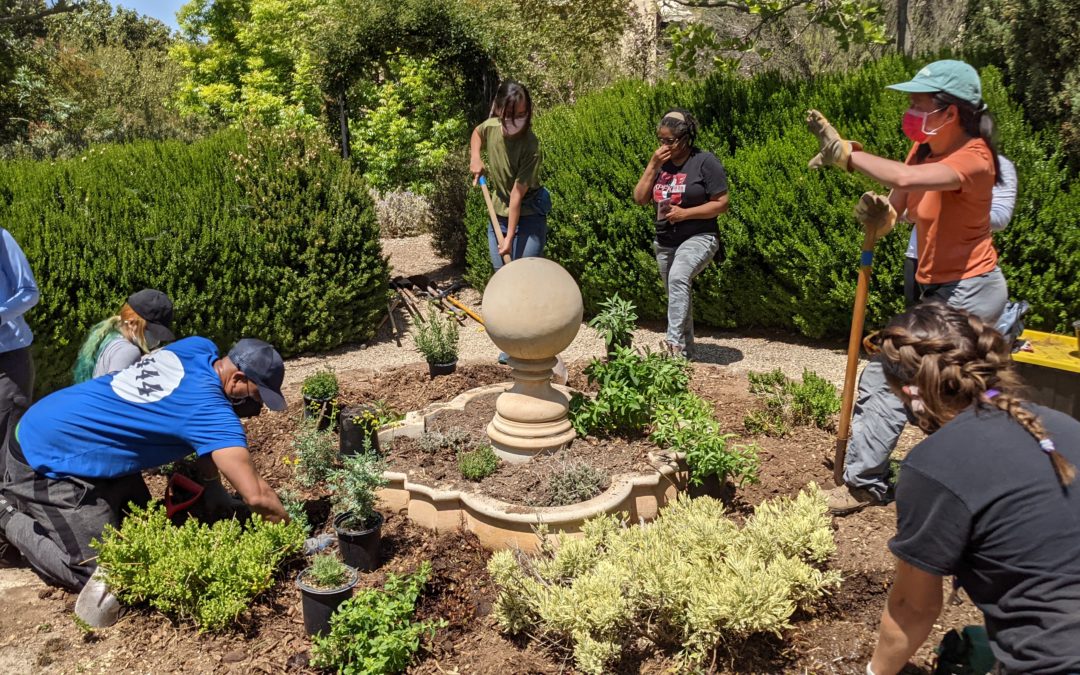
A Climate Change Garden
Andrew Jewell, Communications and Volunteer Manager
It is now widely appreciated that the global climate is irreversibly changed and will continue to change in our lifetimes. The magnitude of the change depends on what human beings can accomplish in the years ahead. The recent IPCCC report shows an average temperature increase between 1.2 degrees C (the most optimistic model) and 3 degrees C (the least optimistic model in which carbon emissions double by mid-century) by 2040-2060. [1]
This means that, within the next 20-40 years, the global average surface temperature will increase by an appreciable amount even in the best case scenario. Even in the best case scenario — and, to be clear, this is not the scenario that current policies put us on track to face — many parts of the world will experience an increase in extreme heat events, flooding, and droughts. This is dangerous to both human beings and the diversity of life on this planet. read more…
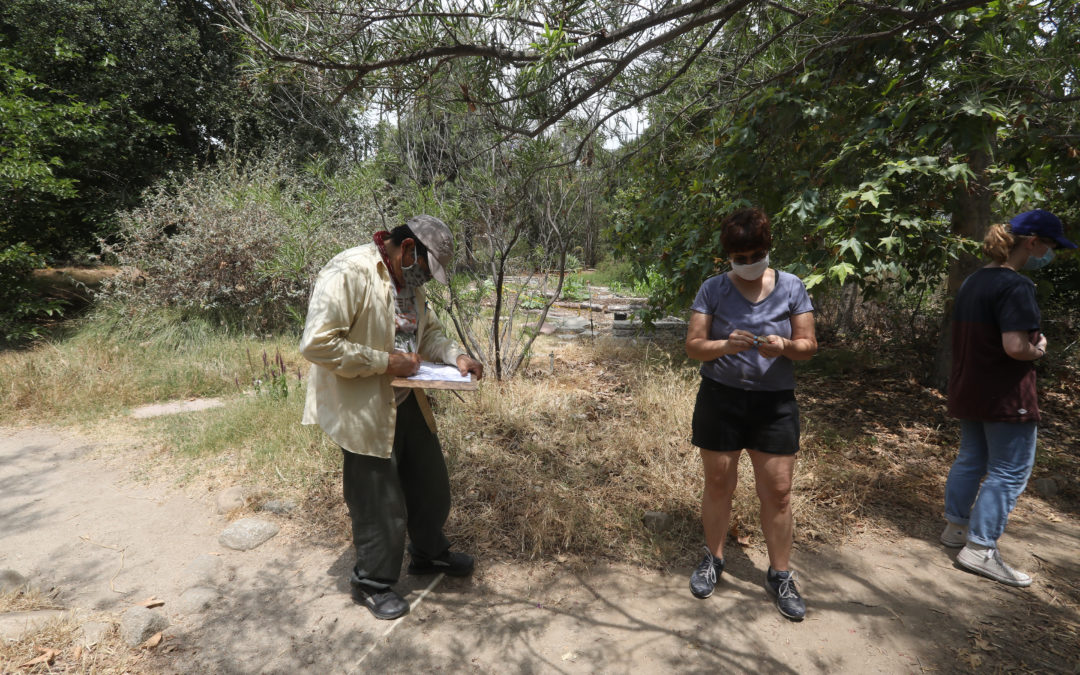
Why a tree survey?
by William Hallstrom (Arlington Garden volunteer)
For the past few months, most of the volunteer crew at Arlington Garden have spent at least some of their time wrapping the trunks of each of the garden’s trees with the kind of soft tape measure you might use for sewing, looking up to the highest branches and pacing underneath them while jotting down notes. It’s all part of the tree survey, one of the recent volunteer projects at the garden, whose goal is to determine how much carbon is being sequestered by the trees in Arlington Garden. read more…
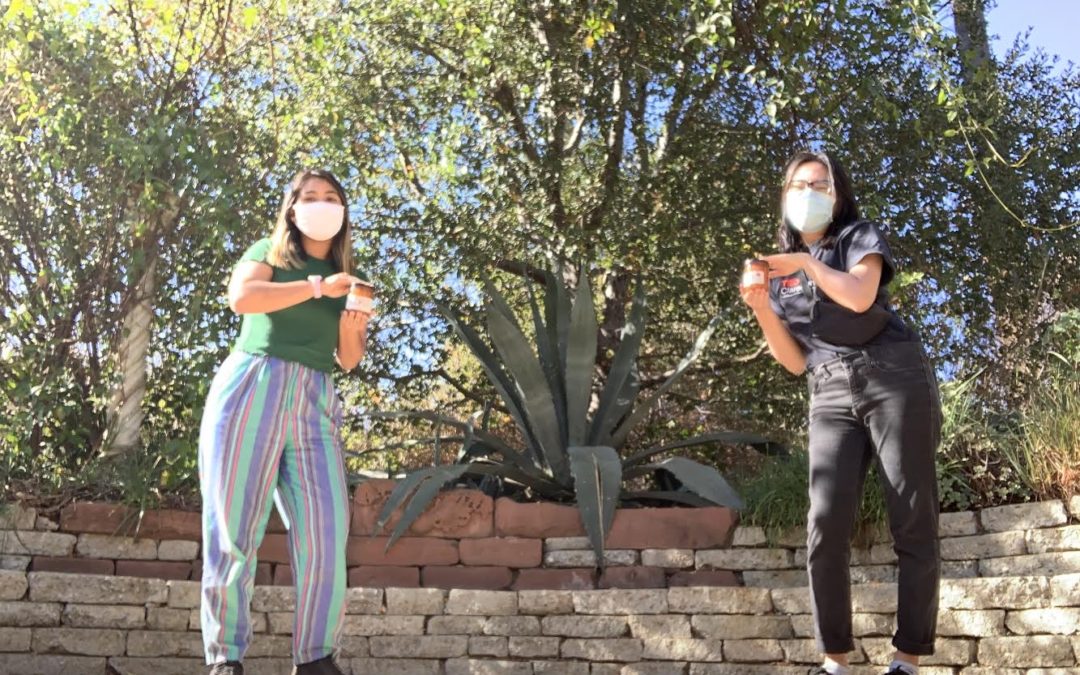
Nature Relations: Evellyn Rosas
Evellyn Rosas and Krystle Yu are members of the LA Nature for All Leadership Academy 2020 cohort. As part of their final project for LA Nature for All, they designed and implemented a digital audio tour for Arlington Garden that you can access here. In this interview, we talk with Evellyn Rosas about the tour, her inspirations, her relationship with nature, and how she is working to promote inclusion in outdoor and conservation circles.
AG: Evellyn, can you tell us a little bit about your background and how it might have led you to LA Nature for All?
Hello, my name is Evellyn Rosas, and I was born and raised in the San Fernando Valley. Since I started living in the San Gabriel Valley about three years ago, the natural surroundings provide a balance in my life. I enjoy finding ways to advocate for people or places that I love by searching for resources online or hearing from friends.
I happened to see the Fall 2020 Leadership Academy application through an Instagram story, so I thought, “If this training is specifically for BIPOC (Black, Indigenous, people of color) interested in environmental protection, I should try it since I identify as a person of color. “If not me, then who? If not now, when?”
The opportunity appeared at the right time when I needed a connection to people and nature during the Covid-19 pandemic.
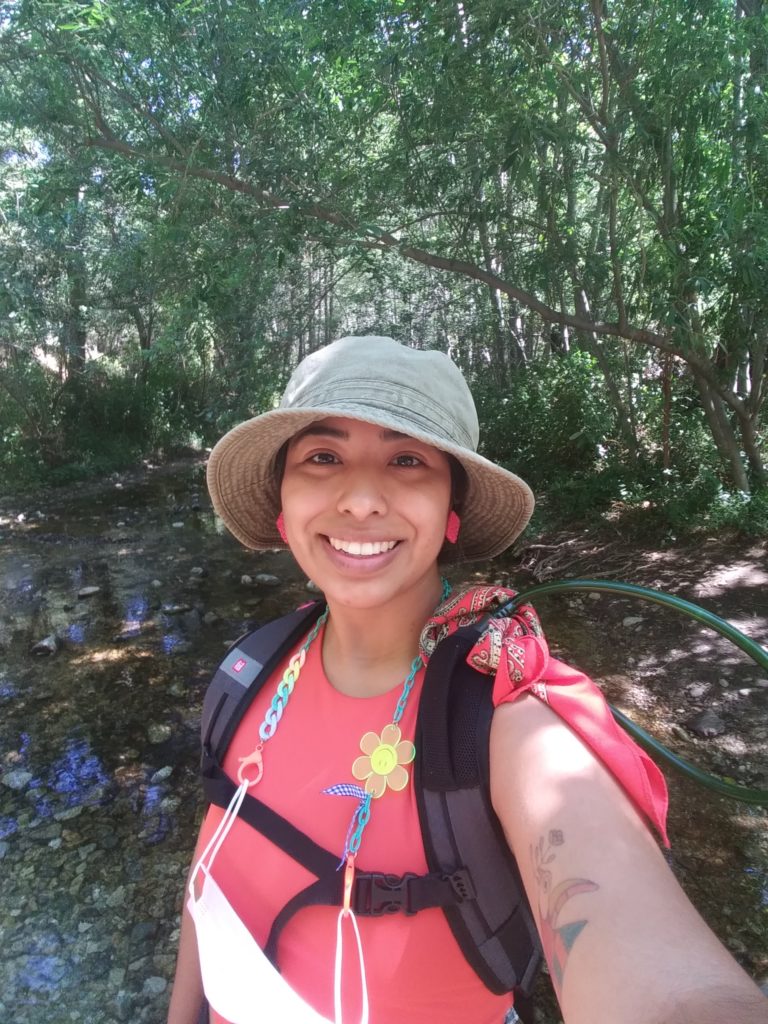 AG: You and your partner Krystle Yu were both part of the 18th Cohort of LA Nature for All Leadership Academy. What is the Leadership Academy? What is its overarching goal or purpose?
AG: You and your partner Krystle Yu were both part of the 18th Cohort of LA Nature for All Leadership Academy. What is the Leadership Academy? What is its overarching goal or purpose?
The Nature for All Leadership Academy is a leadership training program where Los Angeles community members learn to organize for the environmental protection and enhancement of our mountains, forests, rivers, parks, and urban open spaces. For more information about Nature for All’s mission and programs, you can also visit lanatureforall.org.
To combine what we learned in the Academy, we were asked to organize a community engagement project. Krystle and I combined our ideas to develop a project that advocated for protecting urban green space(s) in Pasadena. Based on the 2016 Los Angeles Countywide Parks and Recreation Needs Assessment, we learned how much of the Pasadena population has accessibility to parks, recreation, and open spaces. Arlington Garden happened to be the ONLY public garden in Pasadena that was still community-supported and open during the pandemic. read more…
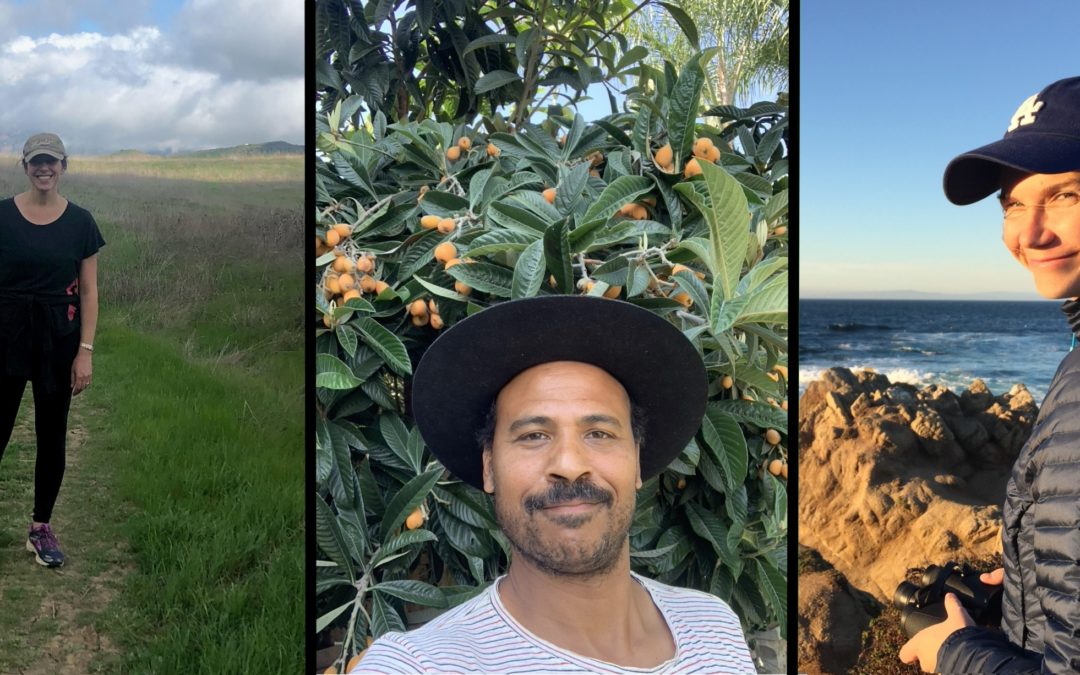
Meet Our New Board Members!
Vishaal Khanna is a project Manager, landscape designer, plant installation layout supervision, plant sourcing, and repository of botanical information at Elysian Landscapes. Melissa Weinberger is co-founder and partner at Touchton & Weinberger LLP. She is a supporter of criminal justice reform and a member of the federal indigent defense panel. Sybil Grant works for PolicyLink, a national research and action institute, advancing racial equity and community-driven public policies.
Arlington Garden: What is your background, and how do you think it will inform your work as a new board member? What are you most excited about working on?
Melissa Weinberger: I am a criminal defense attorney and for the past 15+ years have handled a wide variety of cases in both state and federal court. As one of the few lawyers on the board, I expect to use my legal skills from time to time, and I think my background and experience working in criminal justice will bring a unique and useful perspective. I am excited to work on Arlington Garden events where we bring diverse stakeholders together in a beautiful setting.
Vishaal Khanna: My passion for plants goes back to my early childhood. My Grandmother Sybil was an avid gardener and instilled in me the love and patience of gardening. I studied Botany & Soil Science in school but realized I loved working with people and plants more than labs and wanted to do something that merged the two. My background in Landscape Design informs my perspective on how people interact with outdoor spaces. Thinking how present and future generations will use the gardens is incredibly inspiring! I’m looking forward to bringing more plant education and signage into the gardens and also working on a Master Plan for Arlington Gardens.
Sybil Grant: For the past five years, I have planned, planted, and maintained a native plant garden at my home. My professional background is in political advocacy, working to advance racial equity and pass community-led public policies. I’m excited about our initiatives to bring more outdoor learning opportunities to Pasadena students. read more…
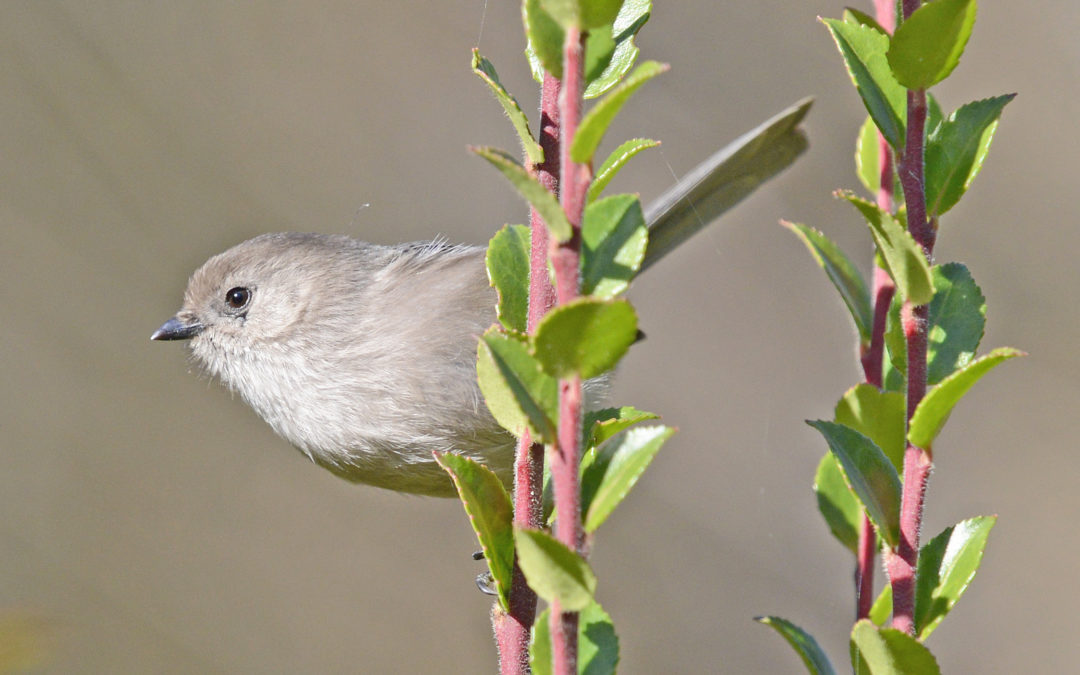
Year-Round Birds of Southern California: Bob Gorcik
Image credit VJAnderson, adult male Bushtit (Psaltriparus minimus)
Bob Gorcik volunteers in Arlington Garden when his work schedule allows him to do so and has been a birder since he was in middle school. As an undergraduate, he had multiple opportunities to as a wildlife research assistant, where he got to study birds up close.
In this month’s column, I will be talking about some of the bird that can be seen in and around Arlington Garden that can be commonly found in parks, gardens, and large residential properties that contain some native landscaping and small habitat fragments but are not likely to be seen right outside your window in your apartment complex’s courtyard.
These birds discussed this month lie somewhere between Wrentits, California Thrashers, and California Quail that are typically only heard and encountered on hiking trails that run through larger tracts of chapparal and coastal sage scrub and those that can easily be found in small city parks in the heart of urban centers, such as mockingbirds, house finches, black phoebes, and hummingbirds. Unlike the birds discussed in my previous segment, these birds discussed below are year-round residents.
One bird that many find to be cute due to their tiny size and their tendency to form large flocks that flit from tree to tree is the Bushtit (Psaltriparus minimus) which can be found nearly anywhere where you have large, branching trees, especially our native Coast Live Oaks. Wherever seed heads of many kinds of trees and wildflowers are allowed to be left on branches, grasses, and wildflowers, you will certainly see pairs of Lesser Goldfinches (Spinus psaltria) in many parks, gardens, and fields. read more…


